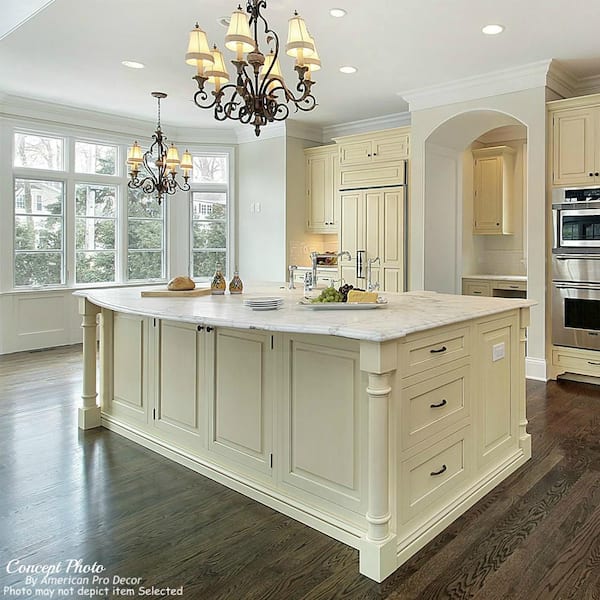A Guide to Choosing the Perfect Legs For Kitchen Area Island for Your Home
Picking the perfect legs for your cooking area island is a nuanced choice that influences both the performance and aesthetic allure of this central area. Factors such as height, materials, and design play an essential duty in harmonizing your island with the total kitchen area design. In addition, comprehending the significance of security and upkeep can substantially influence your choice. As you take into consideration these aspects, it becomes obvious that the appropriate legs can transform not only the appearance of your cooking area however also its use for many years ahead. What particular features should you prioritize in this selection process?

Understanding Kitchen Island Legs
When choosing legs for a cooking area island, it's vital to recognize their functional and visual duties in the general design. The legs work as an essential support group, guaranteeing security and toughness for the island, which often functions as an office, dining location, or gathering spot. The choice of product and construction method need to be robust sufficient to hold up against everyday use and possible wear.
Along with their structural responsibilities, legs add considerably to the island's visual allure. They can improve the cooking area's style, whether through conventional, modern, or diverse designs. The elevation and proportion of the legs are additionally important considerations; they have to integrate with the island's countertop elevation while making sure comfortable seating for those making use of the area.
Furthermore, the leg layout can affect the general flow of the kitchen area. Open, ventilated leg designs can create a sense of agility, while strong, substantial legs might share a more grounded and stable aesthetic - Legs For Kitchen Island. Comprehending these visual and useful elements will lead house owners in making educated selections that complement their kitchen's design and enhance its functionality
Popular Styles and Products
The choice of legs for a kitchen island encompasses a variety of preferred designs and products, each offering one-of-a-kind features that can enhance both performance and visual appeals. Among one of the most desired designs are contemporary, rustic, and traditional. Contemporary legs frequently include streamlined, minimal styles that emphasize simplicity and tidy lines, making them ideal for contemporary cooking areas. Rustic styles, on the other hand, embrace natural components and usually display reclaimed timber or distressed coatings, adding warmth and appeal to the room. Standard legs commonly show ornate information and workmanship, improving timeless cooking area styles.

Height and Stability Factors To Consider

The legs of the cooking area island need to offer appropriate assistance, making sure that the framework can stand up to day-to-day use without wobbling or moving. Product choice plays a substantial function in stability; metal legs, for circumstances, have a tendency to provide higher toughness compared to timber.
Matching Your Kitchen Aesthetic
Picking the appropriate legs for your cooking area island goes past functionality; it also plays a substantial function in the total visual of the space (Legs For Kitchen Island). When picking legs, take into consideration the layout style of your kitchen area.
Color is one more vital aspect. Legs that complement or contrast with your island's surface area and surrounding kitchen cabinetry can produce aesthetic consistency or striking centerpieces. Matching dark wood legs with a light marble counter top can include depth and passion. Additionally, take into consideration the finish of the legs; matte, glossy, or distinctive finishes can dramatically influence the overall feel of the cooking area.
Installation and Maintenance Tips
Installing kitchen area island legs calls for cautious focus to detail to make certain both security and aesthetic allure. Begin by choosing an ideal location for your island, guaranteeing it useful reference is level and has adequate space for activity. If you are affixing the legs to a wall or using braces for added assistance, use a stud finder to situate wall studs. Mark the positioning of the legs properly prior to boring.
When protecting the legs, make use of high-grade screws and, if needed, wood adhesive for additional toughness. For steel legs, guarantee that you are using suitable anchors and devices to avoid damage to your flooring. It is suggested to look for levelness after setup, making changes as needed to prevent tottering.
Upkeep is equally crucial for longevity - Legs For Kitchen Island. Routinely check the legs for any indicators of wear or loosening, specifically in high-traffic areas. Tidy the legs with a suitable cleaner, avoiding rough products that might damage the surface. For wooden legs, take into consideration using a timber conditioner occasionally to preserve their finish. By following these setup and upkeep pointers, you can make sure that your kitchen island legs remain both visually appealing and useful.
Final Thought
In verdict, choosing the proper legs for a kitchen area island necessitates cautious factor to consider of height, security, and aesthetic compatibility. Inevitably, thoughtful leg selection plays a critical function in boosting both the practicality and style of the kitchen area.
When picking legs for a kitchen island, it's crucial to understand their aesthetic and useful roles in the total design. Open, airy leg designs can develop a sense of lightness, while strong, substantial legs may share a more grounded and steady visual. The legs of the kitchen island ought to give adequate support, making certain that the structure can stand up to day-to-day usage without wobbling or moving.Installing kitchen island legs needs cautious focus to information to ensure both stability and aesthetic charm.In final thought, picking the ideal legs for a kitchen island necessitates Learn More cautious consideration of height, stability, and aesthetic compatibility.